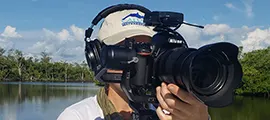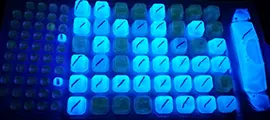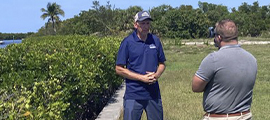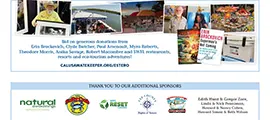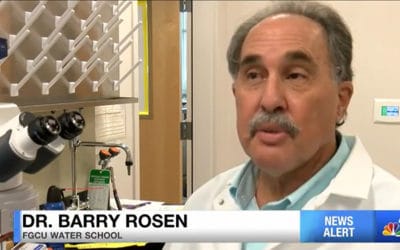Issue:
Stormwater Management

The effects of a rain event from the Caloosahatchee watershed, which often includes Lake Okeechobee discharges.
Stormwater & Nutrient Pollution
As the landscape is cleared for various uses, flood control measures typically create more water quality problems. Stormwater is engineered to run off into canals and waterways much quicker than in the natural systems which allowed for standing water and the filtering of pollutants by wetlands. Ditching, dredging and road building throughout Florida, has altered floways and accelerated runoff in many watersheds. This leads to downstream impacts to receiving waters from stormwater runoff, especially after large rain events.
Stormwater runoff is a dynamic vehicle that introduces many pollutants into our waters, including nitrogen, phosphorous, fecal bacteria, copper, mercury, plastics and more. Whether we’re talking about agricultural or residential uses, the development, fertilization, irrigation and flood control decisions we make on land have a lasting impact on water quality.
Stormwater management and oversight in Florida is a somewhat complex web of government and stakeholder involvement. Land owners, cities, counties and Community Development Districts (CDDs) are all responsible for compliance with the National Pollutant Discharge Elimination System (NPDES) which the state’s Florida Department of Environmental Protection (FDEP) is charged with overseeing. The state’s water management districts also play an important role in flood control projects and stormwater permitting on larger developments.
Many of our other priority issues are related to stormwater loading. For example, Lake Okeechobee discharges are driven by rainfall, carrying legacy nutrients and pollutants. Excess nutrient loading (pollution) of nitrogen and phosphorous are the primary fuel for harmful algal blooms.
When water on our landscape is not allowed time to percolate through the ground or a riparian buffer, it is often inadequately treated in stormwater treatment areas or drained directly into our waterways, taking contaminants with it.
Nutrients & Other Impairments
The Florida Department of Environmental Protection (FDEP) oversees the assessment and verification of impairments to Florida waters. There are a variety of parameters that cause impairments, with the most common being for nutrients (nitrogen or phosphorous), dissolved oxygen, fecal indicator bacteria, turbidity, copper and mercury.
The process of classifying, grouping and assessing our waterbodies is quite laborious and complex. In our view, both the Basin Management Action Plans (BMAP) and accompanying Total Maximum Daily Loads (TMDL) programs, created by the Florida legislature, are largely failing to protect and restore Florida’s impaired waters.
At Calusa Waterkeeper, we are doing our best to independently analyze the state’s stormwater rule-making process, vet local Municipal Separate Storm Sewer System (MS4) permits, identify possible NPDES stormwater violations and hold FDEP and polluters accountable to monitoring requirements and restoration plans.

By the Numbers
Water Quality Trends in SWFL
In 2021, Calusa Waterkeeper began a novel assessment of our local water quality trends using FDEP’s impairment data. This is a relatively comprehensive and unbiased way of determining local water quality trends.
This impairment assessment summary also represents a baseline that can be easily updated from annual FDEP comprehensive verified lists in association with evaluation criteria, such as population growth, that contribute to impairment as presented here. A relatively narrow initial period of record was chosen that would include the latest changes in assessment criteria for added inter-year comparability.
The summary may also provide a basis for evaluating restoration effectiveness by understanding net change in impairment through time.
Read More
Related News Stories
Stormwater
Pollution Verified in Most of Southwest Florida Area’s Prized Water Bodies
What’s been long suspected now is official: Southwest Florida’s most cherished waters are in trouble. From Charlotte Harbor south to San Carlos Bay, a draft state report shows widespread pollution from the fertilizer nitrogen and the algae byproduct, chlorophyll. Many of them also contain unhealthy levels of fecal bacteria.
Large Plumes of Discolored Water Spotted in Estero Bay
FGCU’s Water School put a sample of water under a microscope from a local beach. They found multiple kinds of algae, meaning they were being fed by that same nutrients. “It’s just a question of extra nutrients that man would put in to keep it growing,” said Dr. Barry Rosen from FGCU.
Wetland Permits Seem to Rise Since State Took Over Clean Water Act Section
A former high-ranking Florida Department of Environmental Protection official says more wetlands are being targeted for development now than just nine months ago when the federal government had oversight of what’s known as Section 404 of the Clean Water Act.
Calusa Waterkeeper Concerned About Impact of Large Storm Plume Seen in Naples Bay
A large plume of storm runoff could be seen from Naples Bay through Gordon Pass. That plume has since dissipated into the Gulf but there remains an underlying issue for water experts. We’re seeing more nutrients in SW FL waters so the question is, could this cause more problems?
Tropical Storm Elsa Could Worsen the Blue-Green Algae Situation in SWFL
New pictures taken over Lake Okeechobee show huge swaths of blue-green algae and Tropical Storm Elsa could make things worse. “Our pilot flew the lake yesterday and there was about a 12 mile stretch of the lake where it was concentrated for sure,” John Cassani, from the Calusa Waterkeeper, said.
Guest Opinion: Stating the Facts About Water Quality in Lee County
There is no comparison between what happened in Flint Michigan and what is now happening in SW Florida. For the record, I would like to state a few facts about water quality in Lee County and then the readers can make up their own minds on how competent our state and local officials are.
Make a Donation
Get Notified
Priority Issues
Harmful Algal Blooms
Cyanobacteria & Red Tide
Cyanobacteria (blue-green algae) and Karenia brevis (red tide) have been making major impacts on Southwest Florida.
Lake Okeechobee Discharges
Revise System Operating Manual
The Caloosahatchee River often suffers from too much freshwater in the wet season, and not enough freshwater in the dry season.
Cape Coral Spreader Canals
Nutrient & Sediment Loading
The City of Cape Coral is working to remove large storm-water barriers to make recreational boating more convenient.
Bacteria Monitoring
Fecal Indicator Bacteria
Calusa Waterkeeper has been at the forefront of monitoring this Fort Myers tributary for fecal bacteria indicators.







